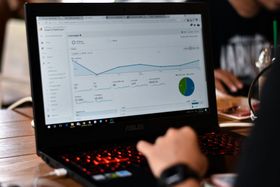Dynamic Ads, Demystified (Finally!)
Are dynamic ads difficult to run? Are they profitable? Who should run dynamic ads? Here's everything you need to know about this type of advertising.
Published November 5, 2024.

Maybe you heard about them in passing, or maybe a PPC agency spoke about them in a podcast you listened. Maybe you want to run them, or maybe you're just testing the waters and trying to get a better understanding of what's out there in terms of pay-per-click/ paid marketing.
Whatever it may be the reason for your research right now, you should know by now that dynamic ads are an undoubtedly powerful tool that can greatly enhance your PPC strategy and drive better results for your business.
If they do feel a bit confusing, though, it's easy to understand why: there's a lot of information out there, and a large part of it might be either siloed, or plain and simply contradictory.
Worry not, though. In this article, we're taking a quick, but comprehensive dive into what dynamic ads are, the main types of dynamic ads, and how to make the most out of this type of digital advertising. Keep reading to find out more.
What are dynamic ads (really)?
Dynamic ads are personalized advertisements that automatically change and present content tailored to individual user preferences and behaviors. Unlike static ads, dynamic ads leverage data and algorithms to create a more engaging user experience by serving content relevant to the user's previous online interactions.
By dynamically altering elements such as the message, images, or product offers, these ads aim to increase the likelihood of conversion -- precisely because they deliver personalized, targeted content, at scale.
The main advantages of dynamic ads
Dynamic ads offer significant advantages for advertisers looking to enhance their marketing strategies. By leveraging personalization and automation, these ads not only engage audiences more effectively but also drive conversion rates higher.Types of dynamic ads (by channel)
Enhanced personalization
Dynamic ads allow for highly tailored content delivery, ensuring that advertisements resonate with individual audience members. This level of personalization increases the likelihood of user engagement, as consumers are presented with relevant products and messages. As a result, businesses can foster stronger connections with their target audience.
Improved engagement
The interactive nature of dynamic ads captures attention and encourages user interaction, leading to higher engagement rates. By presenting content that aligns with user preferences, advertisers can create a more immersive experience. This heightened engagement often translates to increased time spent with the brand and greater interest in the offerings.
Higher conversion rates
Dynamic ads are designed to drive actions, resulting in improved conversion rates for advertisers. By showcasing relevant products and promotions, these ads effectively guide users through the purchasing journey. The more aligned the ads are with consumer interests, the more likely they are to convert, ultimately boosting sales and revenue.
Efficient testing of creative elements
The dynamic capabilities of these ads empower advertisers to experiment with various creative components seamlessly. This ongoing testing process provides valuable insights into what resonates most with audiences, allowing for quick adjustments to strategies. As a result, advertisers can enhance overall ad performance by focusing on the most effective elements.
Automation of content updates
With dynamic ads, content updates are automated, ensuring that advertisements are always in sync with the latest product offerings and user interests. This automation reduces the need for manual intervention, allowing teams to allocate time to other strategic initiatives. Consequently, advertisers can maintain agility in a fast-paced market, adapting to changes without the added workload.
Dynamic search ads (DSAs) utilize the content from a website to automatically generate ad headlines and landing page links tailored to the user's search queries. This type of ad is particularly effective for businesses with an extensive inventory, as it dynamically matches user search intentions with relevant web content.
The main types of dynamic ads
There are a lot of variations on dynamic ads, as most advertising platforms offer some sort of version of this type of advertising. However, when you take a step back, they can all be categorized into five main categories, as follows:
1. Dynamic search ads
Dynamic search ads (DSAs) are a type of dynamic ad that automatically create headlines and landing page links based on the content of a website, allowing businesses to target user search queries more effectively.
This automated approach is particularly advantageous for companies with large product inventories or frequently changing offerings, such as e-commerce retailers and travel agencies, where manually creating ads for each item would be labor-intensive.
By using DSAs, your business can efficiently reach potential customers with ads that closely match user search intent, leading to higher relevance and improved conversion rates.
(Source)
Dynamic search ads vs responsive search ads
Before we move on with the next dynamic ad category, we must mention that there is a difference between dynamic search ads and responsive search ads. Specifically, while both dynamic search ads (DSAs) and responsive search ads (RSAs) prioritize user search intent, they differ in execution.
DSAs focus on matching website content with search queries, automatically generating headlines. In contrast, RSAs allow advertisers to input multiple headlines and descriptions, and then use machine learning to test and serve the best combinations based on user engagement trends.
2. Dynamic display ads
Dynamic display ads adapt their content to match a user's interests and behaviors across the web. These ads can showcase product recommendations, special offers, or customized messaging based on a user's past interactions. In essence, dynamic display ads use website activity data and can optimize ad creative to increase relevance and engagement across Google's Display Network or other programmatic platforms.
Businesses in industries such as retail, travel, and finance can leverage dynamic display ads to target audiences with personalized content in real-time, increasing the chances of conversions. They also offer valuable data insights into consumer behavior and interests, allowing businesses to refine their ad strategies continually.
Advertisers can run display ads on various platforms, including Google AdSense and programmatic networks like AdPushUp and BidVertiser, which offer extensive reach and precise targeting capabilities.
3. Dynamic video ads
Dynamic video ads use AI-driven technology to tailor video content based on user preferences and viewing history. These types of ads are highly engaging and are gaining popularity due to the rise of online video consumption. By personalizing video content for each viewer, businesses can increase brand awareness and engagement while delivering targeted messages that align with user interests.
Dynamic video ads are particularly effective for driving upper-funnel objectives, such as brand awareness or consideration, as they can capture user attention and create a more personalized experience.
Platforms like YouTube, TikTok, and Instagram are particularly popular for dynamic video ad placement due to their extensive user reach and targeting capabilities.
4. Dynamic social ads
Dynamic social ads are personalized ads delivered via social media platforms, leveraging user data to tailor messages.
Here are some examples of how Facebook and LinkedIn (two of the most popular social media networks) use dynamic advertising:
Dynamic Facebook ads
Dynamic Facebook ads automatically display the right products to people interested in them, targeting users who have visited a business's website or app. For example, if you go to an eCommerce website and view a specific product, you may see an ad for that product pop up in your Facebook feed later.
(Source)
Dynamic LinkedIn ads
Dynamic LinkedIn ads are designed to harness user data and professional insights to deliver highly personalized advertising that engages users effectively.
Follower ads
Follower ads are designed to grow a company or personal profile's follower base. They dynamically serve personalized ads featuring the target audience's profile data and encourage connections or follows, effectively expanding the reach and influence of brands or individuals.
Spotlight ads
Spotlight ads highlight a product, service, or event using personalized user information to capture attention. They can drive traffic to a website or specific landing page, making them a powerful tool for engagement and lead nurturing on LinkedIn.
Content ads
Content ads promote specific content pieces, such as articles, reports, or whitepapers, adjusting the presentation based on LinkedIn user insights. These ads boost visibility and encourage content interactions, enhancing brand authority and generating qualified leads.
5. Dynamic podcast ads
Dynamic podcast ads insert tailored audio advertisements into podcast streams, targeting listeners based on their preferences, location, and behavior. These ads can be updated in real-time, providing fresh and relevant content for different audiences and increasing engagement rates.
A note on dynamic remarketing ads
Dynamic ads and remarketing ads are frequently placed in the same bucket, and that's not entirely incorrect. Dynamic remarketing ads retarget users who have previously interacted with a brand's website or app. By using data such as past viewed products or abandoned shopping carts, these ads craft personalized messages, enticing users to complete transactions or engage further, thereby boosting conversion prospects.
Dynamic remarketing is commonly used in eCommerce PPC advertising (because it can help with cart abandonment), travel (due to trip planning behavior), and finance (where users often compare multiple product options). By targeting those who have already shown intent, dynamic remarketing ads can be highly effective in driving conversions. but it can also be applied to other industries, such as travel or finance, where users have a high intent to purchase.
(Source)
Should you run dynamic ads?
Dynamic ads have revolutionized the online advertising landscape by enabling businesses to serve highly personalized content based on user data. Not only have they stuck around in PPC advertising, but dynamic ads are now getting even better, as they use AI and machine learning technology. This allows them to improve relevance, engagement rates, and conversion rates.
As digital platforms continue to evolve and gather more data on user behavior and interests, dynamic ads will become even more critical for businesses looking to reach their target audiences effectively.
Should you run dynamic ads, though?
While this type of advertising can be really successful, it is essential to have a well-thought-out strategy before jumping in. It's crucial to establish clear objectives, understand your target audience, and leverage data effectively to deliver personalized content that resonates with users. Additionally, regularly analyzing and refining your dynamic ad campaigns is crucial for long-term success.
And if you need help with your dynamic ads, don't hesitate to contact Mayple -- we've vetted the best PPC agencies and PPC experts, and we can match you with the ones that are best for your specific needs. What's more, we'll provide you with the best matches in less than a few days, you have no contract minimum to deal with, and we'll handle expert management for you too.
Contact us and let's talk about your paid advertising goals!







